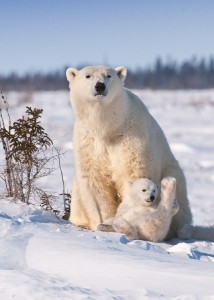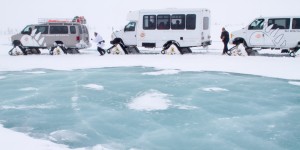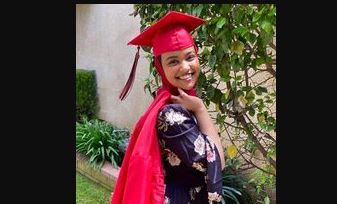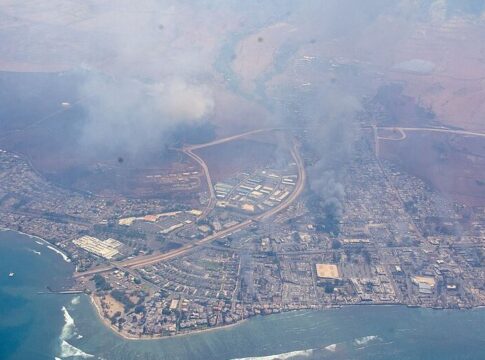 (Note from the editor: This is part of our ongoing series with San Francisco Bay Area wildlife photographer, Breene Yuen. Today’s Adventures with Breene takes you to the Wapusk National Park of Canada, 900 miles north of Minneapolis.)
(Note from the editor: This is part of our ongoing series with San Francisco Bay Area wildlife photographer, Breene Yuen. Today’s Adventures with Breene takes you to the Wapusk National Park of Canada, 900 miles north of Minneapolis.)
All photographs copyrighted by Breene Yuen
I understand it can get colder than -58 F in the subarctic. What possessed you to want to freeze your buns off like that?
An opportunity to photograph polar bear moms and cubs – that says it all!
Up until year 2006, I’ve always been a nature-landscape photographer. I would plan my vacations visiting various State and National Parks with awesome hiking and scenery. In 2006, I decided to change things up and try my hand at wildlife photography. I went big and decided on polar bears! I knew the polar bear habitat was in-danger and I knew that photographing polar bears was going to become harder going forward. So, I did some travel research and learned there are several ways to view and photograph polar bears. The time of year you go, the tour company
you choose, how flexible you are, and the money you can afford to spend are
considerations in making a polar bear viewing/photography trip fruitful. I choose
to focus on the polar bears of the Wapusk National Park, Manitoba, Canada.
LATEST STORIES
What month did you go and how cold did you get?
There are two primary seasons for polar bear viewing in Canada.
One is October/November – no newborns this time of season, but I did see some
one and two year olds with their mother.
The second season is the only chance to see polar bear moms and their newborn
cubs. That’s in February/March.
In summer, there are a small number of polar bears who reside locally. You may
be fortunate to see a polar bear during the summer time.
On my trips to this area, I experienced temperatures from
0’C (32’F) to -50’C (-58’F) during the November and March trips.
During summer, 60’F is typical, accompanied by lots of bug bites!
(To clarify, Wapusk National Park is in the Subarctic, not the Arctic).
What is it like to be outside in temperatures like that?
In the October/November season, polar bear viewing is typically done from
‘Tundra Buggies’. Everyone is in an enclosed vehicle, with all the passengers
sitting around 8 to 10 feet off the ground in these buggies with huge wheels.
Extreme weather outer wear isn’t required here. But, be ready! Nearly all the
windows open up to take photos when bears are sighted! Plus, you may want to move
to the outside deck at the back of the vehicle to get some photos from that
viewpoint if it gets crowded on that one side of the vehicle!
It’s in the February/March tours, with a different tour company, where you’ll
need to step outside the vehicle and setup your camera gear when a polar bear
is sighted by her den, or taking a short rest with her cubs on her way to
Hudson Bay to hunt seal! Here, extreme weather outer wear is a necessity.
 When you visit the North for the first time, the tour operators will let you know
When you visit the North for the first time, the tour operators will let you know
what you need to bring with you to keep you comfortable and warm. Whatever you
choose not to buy or bring with you can be rented or purchased in town upon
arrival. Once you arrive in the town of Churchill, you’ll typically be greeted by
one of the tour operators. They took the time to inspect the outer wear I brought
with me. I had a chance to check that the rented snow pants-bib and snow boots fit.
Being out in -40’C weather for the first time was chilling! I remember stepping out
of the vehicle for the first time. My parka was not zipped up. It took about 3 steps
to realize that the first priority was to zip-up! All the heat in my upper body
had dissipated! Gotta be careful to wear sun screen and moisturizer on the
exposed parts of your face. I had developed a slight frostbite on the tip of my nose
that first day. Keep your head warm! I’m glad I rented snow boots – no problems
with keeping my feet and toes warm. But, chemical warming packs did add some
comfort.
The difficult thing for photographers in that weather is keeping your hands warm.
Insulated thick mittens are best at keeping your hands warm. But, they are useless
when you need to operate a camera! In -40’C weather, if I took off my gloves, my
hands would be numb in about 2 minutes. I’d have to race back into the vehicle
to warm up again. Once you lose body heat in that weather, it takes quite some
time to get your circulation and feeling back. Most of us photographers kept our
hands and fingertips warm with a mix of chemical hand-warming packs, flexible
gloves, that-when not handling camera controls-were placed in big over-sized
mittens. Using some kind of remote control to trigger the camera shutter was
typical. Every photographer there gets a numb feeling in the fingers and hands
the longer we’re out there. You hate to leave your camera, especially when the
bear, can, at any time, get up and leave. So, we’re all doing our best to catch
a few photos, and get our hands back into our mittens and squeeze those warm
chemical packs! Those chemical packs include a warning not to place them directly next to
your skin. At -40’C, nobody pays attention to that recommendation! You can be
comfortable in -40’C temperatures, but not when you’re trying to take photos!
[photoshow]
What were your accommodations like?
The October/November Tundra Buggy tours have a couple of lodging options. You can choose to lodge in the town of Churchill – (This is not the preferred choice, when you want to
optimize bear-viewing time. Keep in mind the days are shorter that time of year. You’re
using maybe 1.5 to 2 hours a daylight just commuting between the town and the polar bear
viewing areas). The other option is to choose the tour that is sets up temporary lodging
right in the primary viewing area. In these tours, the tour company actually transports
the equivalent of 2 train sleeper cars to the area as a temporary camp. The sleeper cars are actually a collection of bunk-bed/cubby holes. Hot meals, warm interiors, running hot and cold water are available.
About 40 guests can share 4 bathrooms and 2 showers.
The February/March tour company has lodging in an old military barracks. It’s rustic,
but comfortable with bunk beds and shared toilet facilities. There’s no running water, but they do have a big tank of water. Wood stoves and plenty of big pots hold warm water.
Men and women both have a ‘sauna’ like area, where you give yourself a private
sponge bath. There is cook with full kitchen – good food!
When time did it get light? What time did it get dark?
Sunrise is around 8 to 9am. Sunset occurs around 5pm.
With the October/November tours, you pretty much can expect to go out on the vehicles
and attempt to see bears every day. Only when the weather gets stormy or blizzard-like
will the day touring be cancelled. Keep in mind that visibility and foggy
weather can severly hamper your chances of viewing bears. As weather conditions
worsen, the bears tend to hunker-down.
With the February/March tours, weather and conditions are more of a factor.
Each morning, 3 scouts head out on snow-mobiles looking for signs of bears.
Gotta have sunlight to see bear tracks on white snow! Likewise, to see puffs
of steam from a polar bear’s breath escaping from a known den site! If the wind
kicks up, sightings become more reliant on luck.
After giving the guides a head-start, the guests follow in snow-vans and snow-buses.
Once the scouts have a sighting, the guest’s vehicles are notified to head to the
sighting coordinates. The scouts draw a ‘boundary’ in the snow with their snow-mobiles
at a safe distance from the mom and cub that may be resting either by their
den, or at a comfy spot on their way to Hudson Bay. The guests empty out of
the vehicles and setup their cameras, careful not to past the designated boundary.
If all goes well, you’ll get maybe 15-20 minutes of photography before the mom may
get restless and scampers off with her cub.
What were sunrises and sunsets like in the arctic?
Sunrises and sunsets vary up North. If visibility is bad, it’ll be grey and dull.
But, you may be fortunate and catch a yellow, or even orange sunrise or red sunset.
With extreme luck, you may capture a nice orange-reddish sunset, with 2 polar bears
nose-to-nose, kissing each other!
How long did you have to stand outside before you saw a polar bear?
For the February/March tours, we all stay in the vehicles until we get a call from the
scouts that polar bears have been sighted. The exception is for meal breaks, toilet
breaks, or if the weather is calm and if folks are getting restless and need to stretch!
How close did you get to the bears?
From the safety of the big Tundra Buggies of the October/November tours, curious
bears have come right up to the sides of the vehicles, and stood on their hind legs,
and leaned against the buggy, checking to see if they can reach the food inside!
Some polar bears seem to be familiar with the Tundra Buggies, and have no problem
playing as close as 50 feet from the Buggies. But, a majority of them just scamper away.
For the February/March tours, we’re about 200 to 250 feet away from the bears. That’s
quite a distance to photograph from. Long lenses are a necessity. Folks should plan
on a minimum focal length lens of 500mm. Bring your tele-extender and a DSLR with
a cropped-frame sensor!
What was the likelihood the bear would come charging at you and have you for dinner?
Very unlikely. That is, if you pay attention to warnings and wisdom of the guides
leading the tour, you’ll be fine. If you’re in a Tundra Buggy and a polar bear is
standing on its hind legs trying to reach your window, don’t stick your arm out and
try to pet it! You will lose your arm!
For the February/March tours, whenever the vehicles are stopped and the guests are
allowed outside, there will always be a staff member on watch with a rifle. The scouts
are also armed.
Describe any other wildlife you might have seen.
Our group saw ptarmigan birds, an arctic fox, and an arctic hare. Leave it to
the finely tuned eye-sight of experienced bird-watches to catch 2 small black dots
disappearing and reappearing against white snow that were the eyes of an arctic
hare!
What was your favorite picture and why?
The polar bear mom resting with her 2 cubs huddling with her is my favorite polar
bear photo. It is so rare to get this opportunity. [ Reference photo of ‘Polar Bear
Mom and 2 Cubs’ ] Especially since I took the same polar bear mom/cubs viewing tour
twice, in 2010 and in 2012. In 2012, I had no polar bear viewings for 7 days on that trip!
But, once I’d seen my first polar bear in his natural habitat back in November 2006,
I was hooked. There’s no turning back! My appreciation for wildlife and the
natural environment had elevated to a new level!
If someone wants to buy one of your pictures, how do they go about it?
Photo Greeting Cards are available at the following website.
AsAmNews readers should enter coupon code, ‘nature06’, at
the ‘Apply Shop Coupon Code’ button for free shipping – good until 5/31/2014.
http://www.etsy.com/shop/NaturesInteraction?ref=search_shop_redirect
For fine art prints or digital downloads, please go to my other website below.
AsAmNews readers should enter coupon code, ‘nature06’ for
a 15% discount – good until 5/31/2014.
http://www.NatureInteraction.com
Do you have anything else you’d like to add?
If anyone reading this article is inspired to view or photograph polar bears,
I’m happy to pass along some travel information. Just send an email with some
of your questions to: [email protected].







